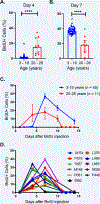Declining neutrophil production despite increasing G-CSF levels is associated with chronic inflammation in elderly rhesus macaques
- PMID: 33974319
- PMCID: PMC9169653
- DOI: 10.1002/JLB.1HI1120-779R
Declining neutrophil production despite increasing G-CSF levels is associated with chronic inflammation in elderly rhesus macaques
Abstract
Aging is characterized by a loss of bone marrow hematopoietic tissue, systemic chronic inflammation, and higher susceptibility to infectious and noninfectious diseases. We previously reported the tightly regulated kinetics and massive daily production of neutrophils during homeostasis in adult rhesus macaques aged 3 to 19 yr (equivalent to approximately 10 to 70 yr of age in humans). In the current study, we observed an earlier release of recently dividing neutrophils from bone marrow and greater in-group variability of neutrophil kinetics based on in vivo BrdU labeling in a group of older rhesus macaques of 20-26 yr of age. Comparing neutrophil numbers and circulating cytokine levels in rhesus macaques spanning 2 to 26 yr of age, we found a negative correlation between age and blood neutrophil counts and a positive correlation between age and plasma G-CSF levels. Hierarchic clustering analysis also identified strong associations between G-CSF with the proinflammatory cytokines, IL-1β and MIP-1α. Furthermore, neutrophils from older macaques expressed less myeloperoxidase and comprised higher frequencies of polymorphonuclear myeloid-derived suppressor cells (PMN-MDSCs) compared to the young adult macaques. In summary, we observed an earlier release from bone marrow and a reduced production of neutrophils despite the increased levels of plasma G-CSF, especially in the elderly rhesus macaques. This lower neutrophil production capacity associated with increased production of proinflammatory cytokines as well as an earlier release of less mature neutrophils and PMN-MDSCs may contribute to the chronic inflammation and greater susceptibility to infectious and noninfectious diseases during aging.
Keywords: aging; hematopoiesis; myeloid-derived suppressor cells; polymorphonuclear cells.
©2021 Society for Leukocyte Biology.
Conflict of interest statement
Conflict-of-interest disclosure
The authors declare no competing financial interests.
Figures






Comment in
-
The good, the bad and the ugly: G-CSF, ageing and neutrophils-Implications for severe COVID-19.J Leukoc Biol. 2021 Jun;109(6):1017-1018. doi: 10.1002/JLB.3CE0121-002R. Epub 2021 Apr 18. J Leukoc Biol. 2021. PMID: 33866607 Free PMC article.
Similar articles
-
Decidua-derived granulocyte macrophage colony-stimulating factor induces polymorphonuclear myeloid-derived suppressor cells from circulating CD15+ neutrophils.Hum Reprod. 2020 Dec 1;35(12):2677-2691. doi: 10.1093/humrep/deaa217. Hum Reprod. 2020. PMID: 33067638
-
NK Cells and PMN-MDSCs in the Graft From G-CSF Mobilized Haploidentical Donors Display Distinct Gene Expression Profiles From Those of the Non-Mobilized Counterpart.Front Immunol. 2021 Apr 27;12:657329. doi: 10.3389/fimmu.2021.657329. eCollection 2021. Front Immunol. 2021. PMID: 33986748 Free PMC article.
-
The efficacy of single-dose administration of thrombopoietin with coadministration of either granulocyte/macrophage or granulocyte colony-stimulating factor in myelosuppressed rhesus monkeys.Blood. 1997 Oct 1;90(7):2565-73. Blood. 1997. PMID: 9326222
-
Lymphokines: enhancement by granulocyte-macrophage and granulocyte colony-stimulating factors of neonatal myeloid kinetics and functional activation of polymorphonuclear leukocytes.Rev Infect Dis. 1990 May-Jun;12 Suppl 4:S492-7. doi: 10.1093/clinids/12.supplement_4.s492. Rev Infect Dis. 1990. PMID: 1694596 Review.
-
Systemic inflammatory response to exhaustive exercise. Cytokine kinetics.Exerc Immunol Rev. 2002;8:6-48. Exerc Immunol Rev. 2002. PMID: 12690937 Review.
Cited by
-
Potential of Mesenchymal Stem Cells in the Rejuvenation of the Aging Immune System.Int J Mol Sci. 2021 May 27;22(11):5749. doi: 10.3390/ijms22115749. Int J Mol Sci. 2021. PMID: 34072224 Free PMC article. Review.
-
HFD aggravated the arthritis and atherosclerosis by altering the intestinal status and gut microbiota.Mol Med. 2024 Dec 23;30(1):270. doi: 10.1186/s10020-024-01014-3. Mol Med. 2024. PMID: 39716053 Free PMC article.
-
How Can We Improve Vaccination Response in Old People? Part I: Targeting Immunosenescence of Innate Immunity Cells.Int J Mol Sci. 2022 Aug 31;23(17):9880. doi: 10.3390/ijms23179880. Int J Mol Sci. 2022. PMID: 36077278 Free PMC article. Review.
-
Neutrophil heterogeneity and plasticity: unveiling the multifaceted roles in health and disease.MedComm (2020). 2025 Jan 21;6(2):e70063. doi: 10.1002/mco2.70063. eCollection 2025 Feb. MedComm (2020). 2025. PMID: 39845896 Free PMC article. Review.
References
-
- Soehnlein O, Steffens S, Hidalgo A, Weber C. 2017. Neutrophils as protagonists and targets in chronic inflammation. Nat Rev Immunol 17, 248–261. - PubMed
-
- Franceschi C. 2007. Inflammaging as a major characteristic of old people: can it be prevented or cured? Nutr Rev 65, S173–6. - PubMed
-
- Eyles JL, Roberts AW, Metcalf D, Wicks IP 2006. Granulocyte colony-stimulating factor and neutrophils--forgotten mediators of inflammatory disease. Nat Clin Pract Rheumatol 2, 500–10. - PubMed
Publication types
MeSH terms
Substances
Grants and funding
- OD024282/NH/NIH HHS/United States
- R21 AI110163/AI/NIAID NIH HHS/United States
- U42 OD024282/OD/NIH HHS/United States
- P51 OD011104/OD/NIH HHS/United States
- HL139278/NH/NIH HHS/United States
- AG052349/NH/NIH HHS/United States
- MH108458/NH/NIH HHS/United States
- U42 OD010568/OD/NIH HHS/United States
- P20 GM103629/GM/NIGMS NIH HHS/United States
- R33 AI110163/AI/NIAID NIH HHS/United States
- GM103629/NH/NIH HHS/United States
- R01 HL139278/HL/NHLBI NIH HHS/United States
- AI097059/NH/NIH HHS/United States
- R01 AI097059/AI/NIAID NIH HHS/United States
- R56 AG052349/AG/NIA NIH HHS/United States
- R21 MH108458/MH/NIMH NIH HHS/United States
- AI110163/NH/NIH HHS/United States
- OD010568/NH/NIH HHS/United States
- OD011104/NH/NIH HHS/United States
LinkOut - more resources
Full Text Sources
Other Literature Sources
Research Materials

